Modern Art in Singapore
Guide Index
- Introduction
- Books, Book Chapters, and Exhibition Catalogues
- Newspaper Articles
- Journal and Periodical Articles (Online)
- Websites
- Audio-visual Materials
- Accessing National Library Board Singapore Resources
- Authors
Introduction
Since the nineteenth century, the definition of the ‘modern’ itself has been debated in Western art-historical and scholarly discourse. This has certainly been no less true in Singapore and Asia at large, where what ‘modern’ and ‘modernism’ refer to are further complicated by larger issues such as the history of European colonialism, the emergence of the nation-state as a new mode of structuring the world, postcolonial awareness, and so on. In short, ‘modernism’ and the ‘modern’ remain complex and contentious, particularly so in the Asian continent. Indeed, as Low Sze Wee and Shabbir Mustafa tell us, curators and art practitioners have intensely debated about “the topic of ‘modernism’ in Singapore, ranging from what definitions, terminologies, and technologies one may adopt to whether there is a specific story to be narrated about the ‘modern’ in Singapore”. 1
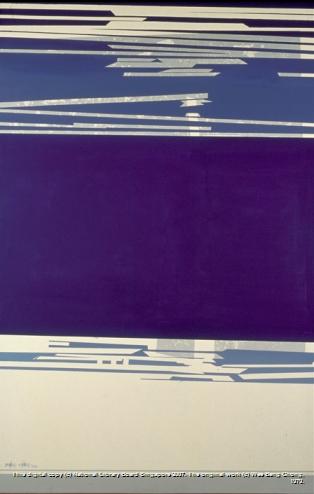
Wee Beng Chong, Painting 1979.
Original work © Wee Beng Chong, 1979; Digital copy © National Library Board, 2007. All rights reserved.
Retrieved from PictureSG.
Twentieth-century modern(ist) art in Singapore was mainly concerned with imagining the ‘local’ and asserting an indigenous identity through aesthetic material that distinctively represents Singapore and the region, such as the Singapore River or even native produce like tropical fruits. This distinguished modernist Singaporean art from Western High modernist art. One of the defining schools or movements of modernist Singaporean art was the Nanyang Style championed by Nanyang Academy of the Fine Arts (NAFA) practitioners (the ‘Nanyang Artists’), which flourished during the 1950s. These artists synthesized the many aesthetic traditions they were formally trained in—from Chinese/East Asian art to the School of Paris—to produce an artistic canon that is clearly Singaporean. Elsewhere, Chinese ink and calligraphic artists such as Chua Ek Kay and Lim Tze Peng also reinvented the practice, reshaping it as a uniquely local tradition. A similar phenomenon occurred with regard to watercolour painting by artists such as Chen Chong Swee.
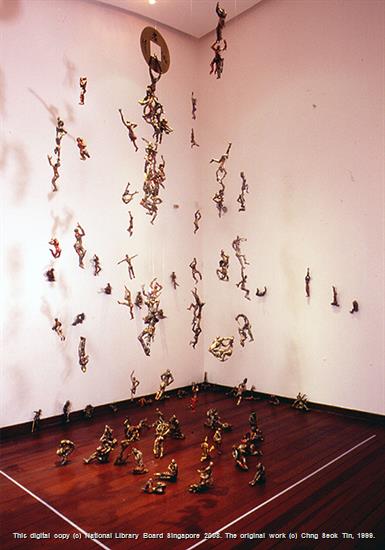
Chng Seok Tin, Men in Colors.
Original work © Chng Seok Tin, 1999; Digital copy © National Library Board, 2008. All rights reserved.
Retrieved from PictureSG.
The ‘localization’ of the modern was further enriched by several key events and conditions, one of which was the historic 1952 Bali field trip undertaken by pioneer artists Liu Kang, Chen Chong Swee, Chen Wen Hsi, and Cheong Soo Pieng, who aspired to recruit Bali as a rich visual resource. Unlike the way in which Euro-American artists approached the ‘East’ as an exotic and foreign Oriental space, these Singaporean artists had a much more nuanced and complicated relationship with Indonesia, our regional neighbour—for them, Bali was not simply a land of exotica, but also one that they personally identified with as part of Nanyang Culture. It has also been noted that at least during the mid-twentieth century, modernist Singaporean art was dominated by Chinese artists at the expense of ethnic minority individuals, which summoned issues of ethnic representation and Singaporean multiculturalism that do not appear in discussions of the ‘modern’ and ‘modernism’ elsewhere in the world.

Thomas Yeo, Head of Ah Beng.
Original work © Thomas Yeo, 1994; Digital copy © National Library Board, 2008. All rights reserved.
Retrieved from PictureSG.
To construct some parameters for this resource guide, we define ‘modern Singaporean art’ as chiefly fine/visual art produced during late-nineteenth century and twentieth century Singapore. However, given the range of meanings and associations that can be ascribed to the ‘modern’ across different spaces and different periods, we also use the term here as an inadvertently open-ended frame of reference; as such, we also include further resources on Singaporean art from before and after this time period to demonstrate that modern Singaporean art can be located within a larger historical continuum, and that the distinctions between the ‘pre-modern,’ ‘modern,’ ‘post-modern’ and ‘contemporary’ can occasionally be blurred.
This guide provides resources for those who are keen to know more about Modern Art in Singapore. You can also visit catalogue.nlb.gov.sg to search for more resources. This resource guide was first authored and updated by Roberta Balagopal and Jason Yan. It was last updated in August 2021 by Nadia Ramli, an Associate Librarian at the National Library, Singapore.
| Search Terms | Call Number |
| The Arts | 700 |
| The Arts: History, Biography | 709 |
| Painting & Paintings | 750 |
| Paintings: History, Biography | 759 |
Books, Book Chapters, and Exhibition Catalogues
| Books | Description |
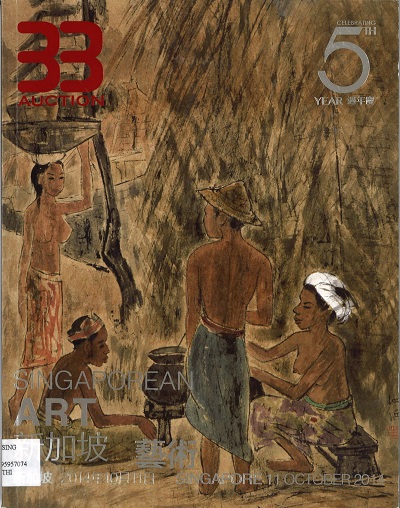
|
33 Auction. (2014). Singaporean art (Singapore, 11 October 2014). Singapore: Author.
Call no.: 759.959597074 THI The might of curators and auctioneers to partially determine the development, prominence, and canonization of an art-world cannot be underestimated, and such is the case in Singaporean art as well. This auction catalog by 33 Auction, wherein some 70-odd works by Singaporean artists in different media and composed over multiple points in art history in different styles, signify as a microcosm of the development of modern Singapore art. Each work, reproduced here in full colour, is accompanied by an informative caption. |
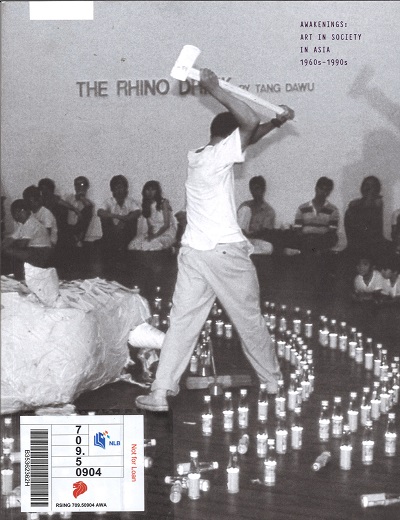
|
Bae, M. et al. (Eds.). (2019). Awakenings: Art in society in Asia, 1960s-1990s.. Singapore: National Gallery Singapore.
Call no.: RSING 709.50904 AWA Published in conjunction with the exhibition of the same name, this publication includes essays from curators from the organising institutions: The National Museum of Modern Art, Tokyo (MOMAT); National Museum of Modern and Contemporary Art, Korean (MMCA); National Gallery Singapore and The Japan Foundation Asia Center. The exhibition adopted a comparative approach to art history within a transnational framework, focused on complex relationships between art and society. Included in this publication are essays on art movements across Asia such as Singapore, Malaysia, Thailand, Korea and Japan. |
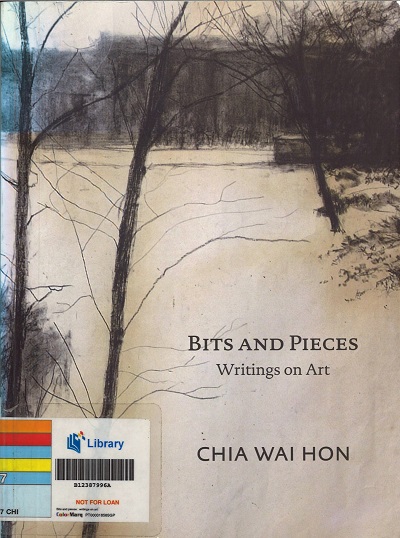
|
Chia, W. H. (Author). Sabapathy, T. K. (Ed.). (2002).
Bits and pieces: Writings on art. Singapore: Contemporary Asian Arts Centre.
Call no.: RSING 709.5957 CHI A compilation of Chia’s disparate and rich contemplations on modern/postmodern Singaporean art, from his reviews of art exhibitions broadcasted over Radio Singapore to his catalog essays and from his papers on art education to published reviews in the 1960s and 1970s. Provides a pertinent insight into the development of Singaporean art over the mid-twentieth century. |
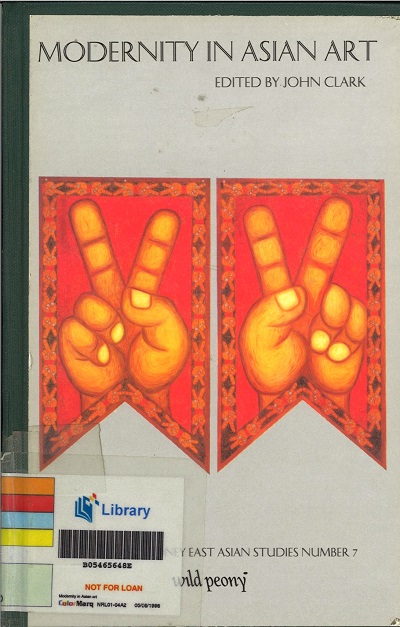
|
Clark, J. (Ed). (1993).
Modernity in Asian art. Broadway, New South Wales, Australia: Wild Peony.
Call no.: RART 709.5 MOD This edited volume of essays variously considers modernity and modernism (as well as postmodernism) in several Asian nation-states and cultural centers such as Thailand, India, and Bandung and Yogyakarta in Indonesia, providing a wider contextual/continental or geopolitical framework to inform an examination of modernity as surfaced in Singaporean art as well as to disarticulate and clarify the meanings of these terms. Of particular note is Clark’s introduction, “Open and Closed Discourses of Modernity in Asian Art.” Works discussed as reproduced and enclosed as appendices. |
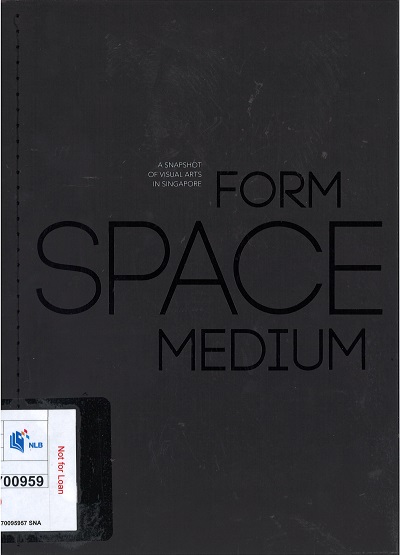
|
Economic Development Board (EDB). (2010). A snapshot of visual arts in Singapore: Form, space, medium. Singapore: Author.
Call no.: RSING 338.4770095957 SNA A brief but succinct EDB publication that, on one level, can be read as a useful documentation of the interactions between (contemporary) art and the state, including the degree of infrastructural and creative support conferred bymy the latter in the present-day. |
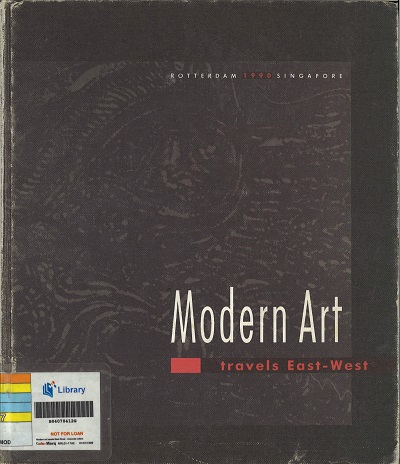
|
Enterprise & Art Foundation, World Trade Center (Rotterdam) & Empress Plcae Museum (Singapore). (1990).
Modern art travels East-West: Corporate collections from Singapore and the Netherlands—Rotterdam Beurs/World Trade Center, June 7-June 24 1990; Singapore, Empress Place Museum, August 10–August 26 1990. Haarlem: Edition Brèoring-de Toorts.
Call no.: RSING 759.95957 MOD Exhibition catalog for the 1990 Enterprise & Art Foundation-organized exhibition, entitled Modern Art Travels East-West, endorsed by the Singaporean and Dutch governments, wherein more than 100 modern artworks from each country were juxtaposed insofar as a comparative approach to global/local modernism(s) is facilitated. The mounted works in question are reproduced as full-colour plates here; the Singaporean section offered seminal works by key modern artists, such as Chen Wen Hsi’s Chinese-ink-inspired Gibbons II (c1970) and Ken Quek’s abstract geometric Kite (Series No. 13) (1987). Constance Sheare’s essay, “Modern Singaporean Painting: An Introduction” proves instructive in elaborating modern Singaporean art and can be read as a counterpoint and in connection to Liesbeth Hemelrijk’s “Modern Painting in the Netherlands: An Introduction.” |
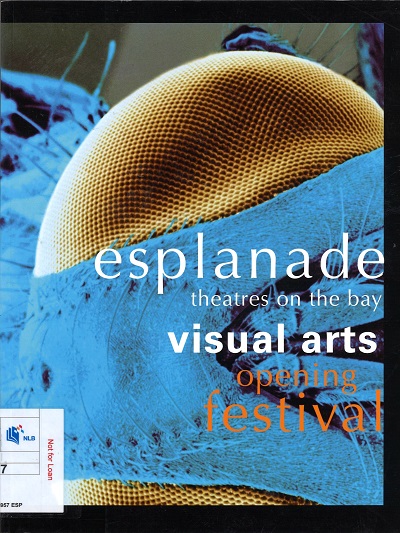
|
The Esplanade Co Ltd. (2002).
Esplanade Theatres on the Bay: Visual arts opening festival. Singapore: Author.
Call no.: RSING q709.5957 ESP Commissioned text that commemorates the Esplanade’s opening on 12 October 2002 and its visual arts program. Multiple works of art, including painting and sculpture, from various periods—so to speak—of Singaporean art history were showcased. ‘Modern’ works were featured including selected oil paintings by Georgette Chen and Teo Eng Seng’s mixed-media installations. |
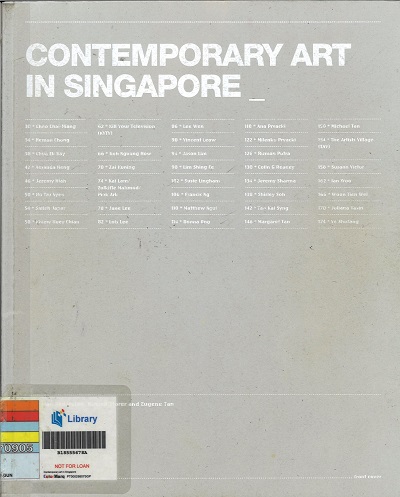
|
Gunalan, N. et. al. (2007).
Contemporary art in Singapore. Singapore: Institute of Contemporary Arts Singapore.
Call no.: RSING 709.59570905 GUN An introduction to contemporary art in Singapore, this publication provides an informative and concise overview of artistic practices, discourses, institutions within the socio-cultural and political milieu. It includes brief biographies and introduction of selected artists, alongside images of their works. Artists featured include Amanda Heng, Lee Wen, Milenko Prvacki and Suzann Victor. |
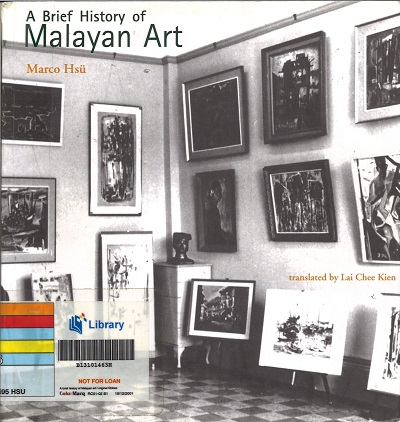
|
Hsu, M. (Author). Lai, C. K. (Trans.). (1999).
A brief history of Malayan art. Singapore: Millennium Books.
Call no.: YRSING 709.595 HSU or RDET 709.595 HSU or RDKSC 709.595 HSU One of the earliest, and extensive, publication on Malayan (Malaysian and Singaporean art) of note is Hsu’s ethnographic/anthropological approach to pre-modern Malayan art and critical evaluation of the colonial enterprise and artistic transmission to illuminate the complex (pre-)conditions in which modern Malayan art developed; this strategy instructively animates Hsu’s at-length examination of modern Malaysian and Singaporean art proper, which comprehensively considers the performing and visual arts, from dance to sculpture and drama to painting, across 11 chapters. Multiple photographs of modern Malayan artists and colour reproductions of their seminal works are included, e.g. Cheong Soo Pieng’s Pounding Rice (1953) and Chia Yu Chian’s Golden Pagoda (1958). |
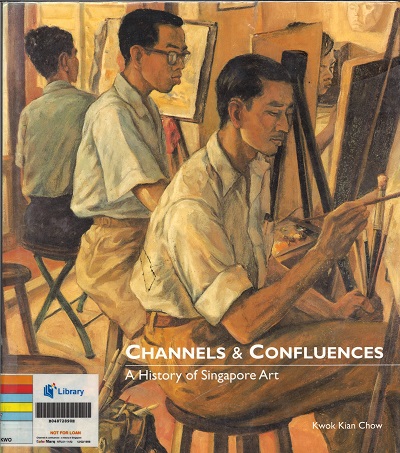
|
Kwok, K. C. (1996).
Channels & confluences: A history of Singapore art. Singapore: Singapore Art Museum, National Heritage Board.
Call no.: RSING 709.5957 KWO Published in conjunction with the 1996 Singapore Art Museum exhibition entitled Modernity and Beyond, this is arguably one of the most comprehensive and sustained examinations of Singaporean art; as its blurb announces, it is the “first fully-illustrated historical survey of Singapore art.” Scrutinizes at length the genesis of modern Singaporean art and its many tributaries, from the Nanyang School to the Singapore Art Society and the Society of Malay Artists, as well as its relationship with other dimensions of social life such as political exigencies and historical events like World War II. Augmented by multiple full-colour reproductions of works by major artists in Singapore art history, from Georgette Chen to Chua Mie Tee and Han Sai Por to Jailani (Zai) Kuning. |
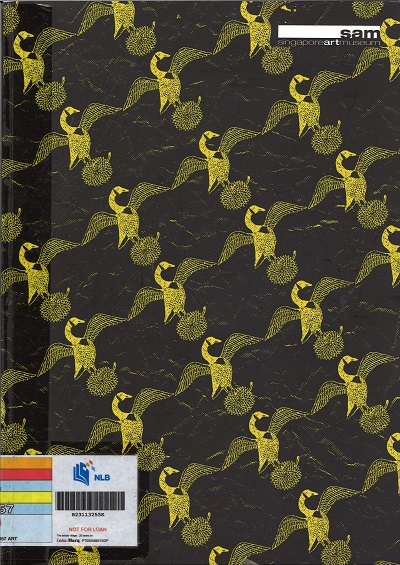
|
Kwok, K. W. & Lee, W. (2009).
The Artists Village: 20 years on. Singapore: Singapore Arts Museum; Artists Village.
Call no.: RSING 709.5957 ART Published in conjunction with the exhibition The Artists Village: 20 years on at the Singapore Art Museum. A visual and chronological timeline of The Artists Village from its inception in 1988 to 2006 provides an overview of its history. The publication includes essays such as “Tang Da Wu and Contemporary Art in Singapore”, “The Artists Village: Collaboration as Transformation” and “Sustaining Alterity in the Times of R(v)apid Changes”. |
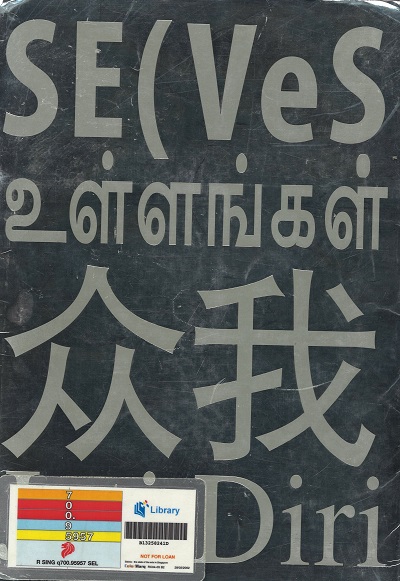
|
Kwok, K. W., Mahizhnan, A. & Sasitharan, T. (2002).
Selves: The state of the arts in Singapore. Singapore: National Arts Council.
Call no.: RSING q700.95957 SEL Sze Wee Low and Han Wue Teo in “Early Modern Art” chart the development of modern art in Singapore with reference to a home-grown canonical movement—the Nanyang Style. Colour reproductions of key works such as Liu Kang’s Bathers (1997) are included. The essay provides a comprehensive historical account of Singaporean art in the early twentieth century that is followed by Joyce Toh’s “Second Generation Artists,” Joyce Fan’s “Three-Dimensional Art,” and Joanna Lee’s “The Artists Village.” |

|
Lingham, S. & Toh, J. (Eds.) (2018).
Medium at large: Shapeshifting materials & methods in contemporary art. Singapore: Singapore Art Museum.
Call no.: RSING 709.05 MED An exhibition catalogue for the exhibition of the same name at the Singapore Art Museum, featuring five curatorial essays reflecting on a range of issues surrounding contemporary art, such as the meaning of material(s) and how a museum collects contemporary art. The exhibition featured contemporary artworks that were made of, and from, rattan, human hair, bullet shells and “dematerialised” media like sound and language. |
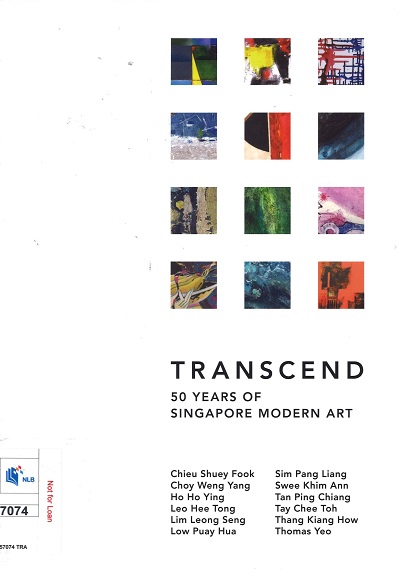
|
Liu, I. (2017).
Transcend: 50 years of Singapore modern art. Singapore: Author.
Call no: RSING 709.5957074 TRA Art catalogue published for the exhibition Transcend – 50 years of Singapore Modern Art, held at the Visual Arts Centre in 2017. The exhibition featured 12 second generation Singaporean artists, whose works and practices were important in the growing Singapore art scene from the early 1960s to 1980s. The artists featured were Chieu Shuey Fook, Choy Weng Yang, Ho Ho Ying, Leo Hee Tong, Lim Leong Seng, Low Puay Hua, Swee Khim Ann, Sim Pang Liang, Tan Ping Chiang, Tay Chee Toh, Thang Kiang How and Thomas Yeo. |

|
Liu, K. & Ho, H. Y. (Authors). Sabapathy, T. K. & Cheo, C.-H. (Eds.). (2005).
Re-connecting: Selected writings on Singapore art and art criticism. Singapore: Institute of Contemporary Arts Singapore.
Call no.: RSING 709.59570904 LIU In explicating the central debates and concerns in 1960s and 1970s Singaporean art, including the preoccupation with wider trans-local art-worlds, Liu and Ho demonstrate the connectedness between modern and contemporary art in Singapore in terms of their similar anxieties and orientations, thus locating the development of Singaporean art (and art history) on a continuum. |

|
Low, S. W. (Ed.). (2014).
Siapa nama kamu?: Art in Singapore since the 19th century. Singapore: National Gallery.
Call no.: RSING 709.5957074 SIA Companion text to the similarly-titled exhibition at the National Gallery; arguably one of the most critically significant resources on Singaporean art in recent publication history. One of the most extensive exhibitions on Singaporean art to date, the showcased works are reproduced as full-colour plates here. The five essays, framed by Sze Wee Low and Shabbir Hussain Mustafa’s introductory remarks, extensively considers various dimensions and avenues of Singaporean art (history)—from the Nanyang movement to the localization/reinvention of the Chinese ink tradition—that precede, constitute, and succeed modern Singaporean art. |
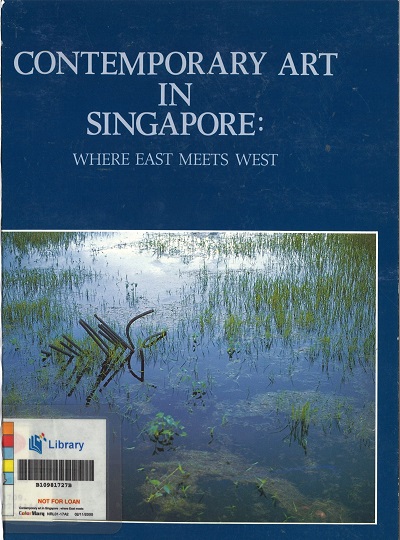
|
Ministry of Information and the Arts (Singapore), the National Museum (Singapore) & the Hunterian Art Gallery, University of Glasgow (the U.K.). (1989).
Contemporary art in Singapore: Where East meets West. Singapore: National Museum.
Call no.: RSING q709.595707441443 CON Exhibition catalog for the similarly-named 1989 exhibition, which showcased works by Singaporean artists, such as Chen Wen Hsi and Tan Swie Hian; colour plates of the exhibited works are featured here along with biographies of the corresponding artists. Provides a representative display of modern and contemporary fine art in Singapore. |

|
National Arts Council & National Heritage Board (Authors). Goh, B. C. (Trans.). (1994).
Window on Singapore art. Singapore: Authors.
Call no.: RSING 759.5957 WIN Exhibition catalog for the 1994 National Arts Council- and National Heritage Board-co-organized traveling exhibition to Hong Kong and various cities in mainland China, where some 57 works of various media by 31 artists spanning the 1940s to the 1990s were showcased. Prefaced by a series of essays, such as Kwok Kian Chow’s illuminative survey of the history of art in Singapore, from the watercolour medium to the Chinese realist tradition, and Shuoqi Xia’s explication of and focus on the Nanyang Style. The exhibited works, which are arguably representative of the development of modern Singaporean art, are reproduced as full-colour plates along with brief explicatory blurbs. Biographies of the featured artists are also included. |
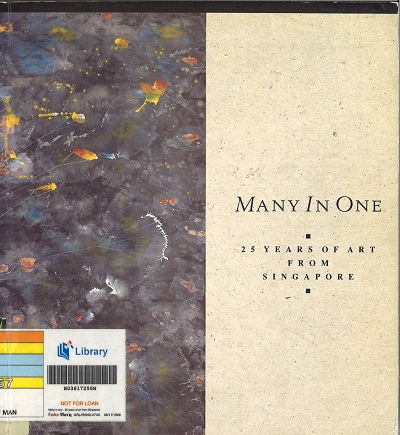
|
The National Museum. (1991).
Many in one: 25 years of art from Singapore. Singapore: Author.
Call no.: RSING 759.95957 MAN or RSEA 759.95957 MAN Exhibition catalog for the 1991 Nation Museum- and Meridian House International-jointly hosted traveling exhibition, Many in One: Twenty-Five Years of Art from Singapore, which was mounted in Singapore and various cities in the States. Nancy Matthew’s preface simultaneously considers Singaporean modernity at large, the space/site of the National Museum, and the featured artists. T K Sabapathy’s introduction instructively proffers heterogeneous ways to read and access works in the exhibition with reference to the multiple articulations of local(ized) modernities; as he discloses, modernism frustrates the compulsion to “construct [a] continuous, unified, seamless narrative… [that] provides wholesome satisfaction.” Colour plate reproductions of all the works exhibited are included. |
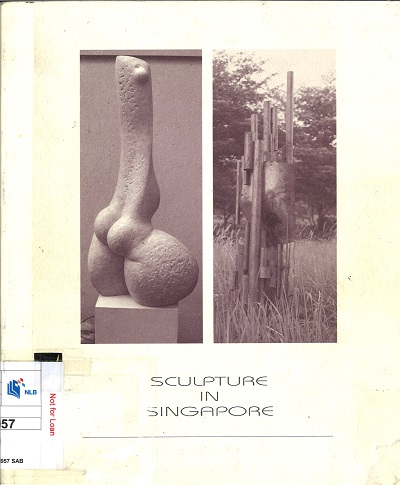
|
Sabapathy, T. K. (1991).
Sculpture in Singapore.. Singapore: National Museum.
Call no.: RSING 730.95957 SAB or RART 730.95957 SAB Features Singaporean art historian T K Sabapathy’s interviews with six sculptors, such as Tang Da Wu and Teo Eng Seng, whose sensibilities informed and shaped the direction of modern Singaporean art with respect to sculpture. Prefaced by Sabapathy’s comprehensive survey and disclosure of the trajectory of Singaporean sculpture, including representative works and exhibitions. Photographs of key installations are included throughout, as is an accompanying catalog of these works. |
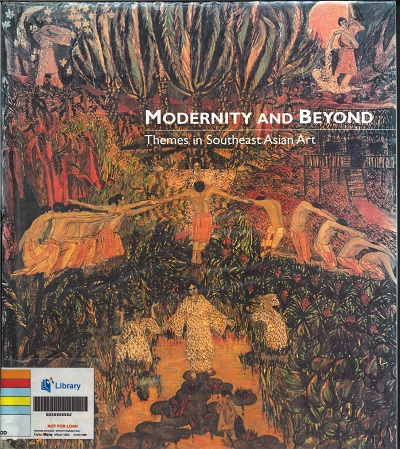
|
Sabapathy, T. K. (Ed.). (1996).
Modernity and beyond: Themes in Southeast Asian art. Singapore: Singapore Art Museum.
Call no.: RSING 709.59 MOD Published to commemorate the opening of the Singapore Art Museum (SAM), this text obtains as the “first foray into investigating and making meaning of the development of modern art in Southeast Asia from the perspective of insiders,” as its blurb discloses. The essays, which variously consider Malaysian art history, modern Thai art’s co-option of traditionalism, and so on, provides a sound framework to consider expressions of ‘modernity’ in Singaporean art through a regional aesthetics. The exhibited works from Singapore and the region are reproduced as full-color plates, and structured according to thematic concerns such as “The Self and the Other” and “Nationalism, Revolution, and the Idea of the Modern,” tropes dominant in Southeast Asian modernism. |

|
Sabapathy, T. K. (Ed.). (1998).
Change: 20 Singapore artists—a decade of their work. Singapore: P. Mowe.
Call no.: RSING 709.5957 CHA Features 20 of Singapore’s most preeminent and prolific artists that are representative of their time and corresponding artistic affiliations. Some 220 full-colour plates of their works are included along with portraits of the artists. |

|
Sabapathy, T. K. (2010).
Road to nowhere: The quick rise and long fall of art history in Singapore.Singapore: National Art Gallery & National Institute of Education.
Call no.:RSING 709.5957 SAB Extended from a lecture by respected local art historian T K Sabapathy, this is an instructive examination of the representations and coming-into-being of the ‘modern’ in Singaporean and regional art through the development and decline of art history, research, and education in the nation. As an interestingly and deeply personal account that references Sabapathy’s transcontinental career and travels, it connects modern Singaporean art to a larger transnational politics and calls attention to how the canon is also imparted by wider, global conditions. |

|
Sabapathy, T.K. (2018).
Writing the modern: Selected texts on art & art history in Singapore and Southeast Asia, 1973-2015. Singapore: Singapore Art Museum.
Call no.: RSING 709.59 SAB An anthology of some of the most important and influential writings of eminent Singaporean art historian T. K. Sabapathy, from over four decades. The 57 pieces of writing includes exhibition reviews, catalogue essays, artist interviews and conference papers. “Trimurti: Contemporary art in Singapore” and “Contemporary art in Singapore: An introduction” provide an introductory overview to the growth of the contemporary art scene. |
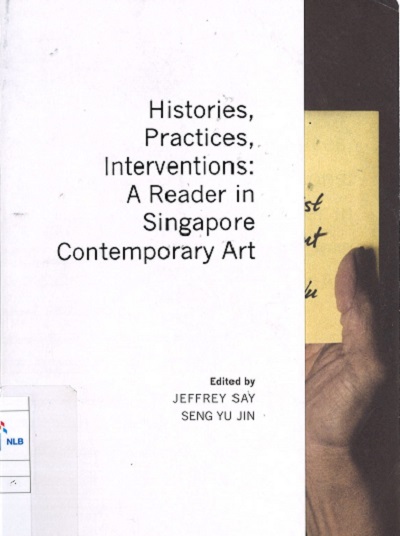
|
Say, J. and Seng, Y. J. (eds). (2016).
Histories, practices, interventions: A reader in Singapore contemporary art. Singapore: Institute of Contemporary Arts Singapore.
Call no.: RSING 709.5957 HIS A collection of 33 essays by art historians, art critics, curators, artists, playwrights and academics, this anthology encompasses a diverse range of writings on Singapore contemporary art since the 1970s. Included in this publication are Wu Mali’s “Artist as Mediator- On Amanda Heng’s Art” (2011), Chua Ek Kay’s “Crossing the Ink Boundary” (1999) and T.K. Sabapathy’s “Interview with Tang Da Wu” (1991). |

|
Seng, Y. J. and Shabbir Hussain Mustafa. (2018).
Art. Singapore: Institute of Policy Studies, Straits Times Press Pte Ltd.
Call no.: RSING 709.5957 SEN As part of the Institute of Policy Studies’s Singapore Chronicles series, Art is a collection of short essays which touch on issues and concerns surrounding art practice, from 19th century to Singapore’s modern and contemporary art history. |

|
Singapore Art Museum (1998).
Imaging selves: Singapore Art Museum (Collection exhibition series, 1998–1999). Singapore: Author.
Call no.: RSING 709.05 MED Companion text to the 1998 year-long Imaging Selves exhibition at the Singapore Art Museum, which showcased both local and Southeast Asian modern art pieces, and wherein, as Joanna Lee and Lindy Poh intimate in their introduction, the “historical incidence of 20th century modernity in Southeast Asia [forms] the contextual backbone” to the exhibition. The multiple essays in this catalog provide a productive introduction to the characteristics and concerns that surround regional modern art, such as the body and anxieties of selfhood, and reference several local modernist artists such as Georgette Chen and Amanda Heng. |
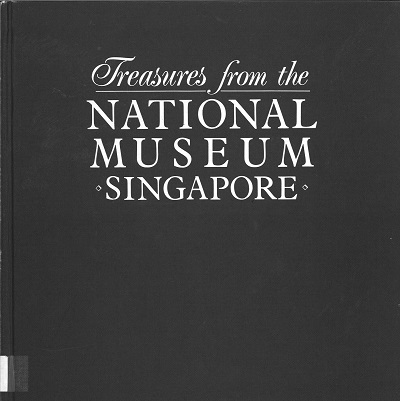
|
Sheares, C. & Koay, S. (1987). Modern art. In Eng-Lee, S. C., et al,
Treasures from the National Museum Singapore. (pp. 236-239). Singapore: Author.
Call no.: RSING q708.95957 TRE – [SRN] Sheares and Koay select works in the National Museum’s art collection (at time of publication) as a point of entry to consider the significance and significations of the modern in Singaporean art, informing us of its history, trajectory, aesthetic tropes and motifs, and ideological concerns with reference to works such as Chen Chong Swee’s Kampong by the Sea (1949) and artists such as Anthony Poon. |
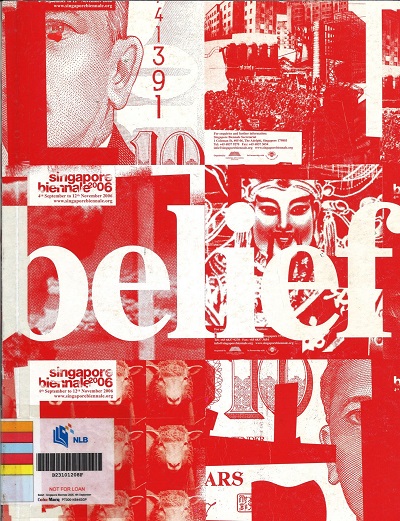
|
Slater, B. (Ed.). (2007).
Belief: Singapore Biennale 2006, 4th September to 12th November 2006.Singapore: Singapore Biennale Secretariat.
Call no.: RSING 709.05 BEL Companion text to the inaugural 2006 edition of the Singapore Biennale. Artistic director Fumio Nanjo concludes with the declaration that a “new age of art has begun in Singapore,” gesturing toward the epochal approach to art history (i.e. ‘Romanticism,’ ‘modernism,’ and ‘postmodernism’ etc.) and qualifying ‘modernism’ as a canon to respond to. Several commissioned works by artists such as Gustavo Romano and Handiwirman Saputra were exhibited in (reclaimed) white-cube spaces at City Hall and Tanglin Camp, a practice that recalls High Modernist art. |
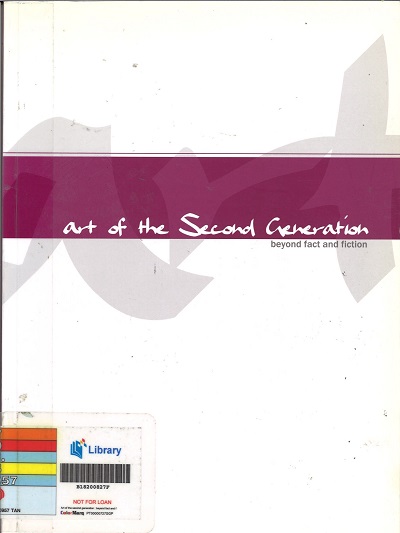
|
Tan, B. T. (2005).
Art of the second generation: Beyond fact and fiction. Singapore: Nanyang Academy of Fine Arts (NAFA).
Call no.: RSING 709.5957 TAN Exhibition catalog published in conjunction with the similarly-titled NAFA exhibition honouring ten of Singapore’s ‘second generation’ artists affiliated with the institution. Bridget Tracy Tan’s introductory essay provides an illuminating and comprehensive overview of the careers and artistic registers of these artists, both individually and collectively, thus gesturing toward the elaborations and implications of modern Singapore art at large. Colour reproductions of the exhibited works appear here. |
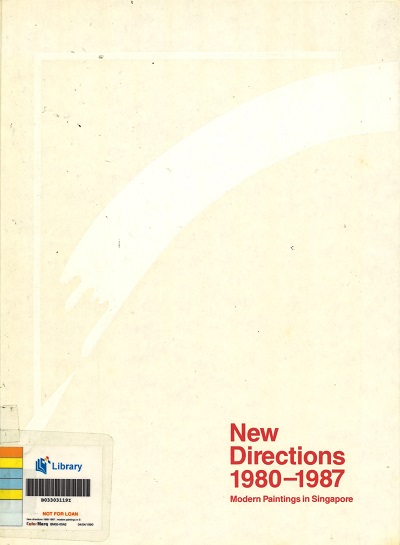
|
Thang, K. H., et al. (Eds.). (1987).
New directions 1980–1987: Modern paintings in Singapore. Singapore: Horizon Publications.
Call no.:RSING 759.95957 NEW Textual resource that showcases artworks of note produced between 1980 and 1987 by Singaporean artists, reproduced in full colour here; each work is accompanied by the corresponding artist’s biography. Prefaced by two essays of particular instruction: Choy Weng Yang’s “Contemporary Art in Singapore in the Mid-Eighties” and T K Sabapathy’s “Forty Years and After: The Nanyang Artists; Remarks on Art and History.” |
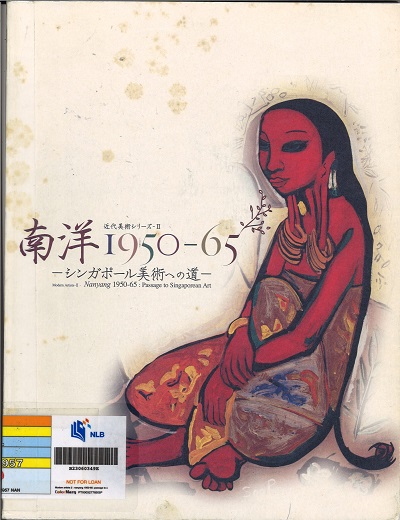
|
Toshiko, R. (Ed.). (2002).
Nanyang 1950–65: Passage to Singaporean art. Fukuoka: Fukuoka Asian Art Museum.
Call no.: RSING 759.95957 NAN Exhibition catalog to the similarly-entitled exhibition by the Fukuoka Asian Art Museum (FAAM), which boasts one of the world’s most preeminent collection of Asian art. Full-colour reproductions of the showcased works, such as Koeh Sia Yong’s Indian Worker (1958), are included along with head curator Rawanchaikul Toshiko’s critical annotations and blurbs on each individual work, which locate these pieces within the Singaporean modern art canon. Toshiko’s essay, published bilingually in English and Japanese here, is an instructive essay that comprehensively explicates the history and trajectory of modern Singaporean art, including its representation of the ‘ethnic(ized) Other’ and engagements with social reality. |
Newspaper Articles
- Beginner’s guide to the Nanyang school of art. (2006, November 30). The Straits Times, p. 3. Retrieved from NewspaperSG.
Briefly introduces the history and characteristics of the Nanyang artistic movement as well as its key practitioners.
- Calligraphy the modern way. (1978, September 1). New Nation, p. 19. Retrieved from NewspaperSG.
Advertises a 1978 exhibition of some 120 calligraphic/ink works by 38 artists at the National Museum Art Gallery that foregrounds the localized artistic practices that reframe and innovate traditional Chinese ink painting, such as the employment of various other paint materials like ballpoint pens, insofar as they become constitutive of an endemically Singaporean art canon.
- Cheah, U.-H. (2015, January 2). Visual arts; works that captured the imagination. The Business Times (Singapore). Retrieved August 6, 2021, from Factiva via NLB’s eResources website. (myLibrary ID is required to access this article).
Article of ten of the most iconic Singaporean works of art from the past half-century; includes various media such as painting, woodcut, and photography.
- Chia, W. H. (1978, December 14). Good sample of all the -isms. New Nation, p. 19. Retrieved from NewspaperSG.
Chia Wai Hon’s review of the 14th edition of the Modern Art Society’s annual art exhibition; Chia elects the exhibition as a point of departure to consider the potential disconnect between modern art/High Modernism and the mainstream gallery-goer, and endeavours to provide a brief introduction to modernist underpinnings for the reader here.
- Chia, W. H. (1986, June 15). A celebration of modern art in Singapore. The Straits Times, p. 6. Retrieved from NewspaperSG.
Here, Chia reviews the Asian Contemporary Art exhibition held as part of the Singapore Arts Festival, which, despite its name, showcased more works by Singaporean artists than their regional counterparts. Chia evaluates various works by Singaporean artists such as Chen Wen Hsi, Jaafar Latiff, Teo Eng Seng, and Anthony Poon in terms of their intertextual/intercultural artistic affiliations and reframings as reflective of a larger modernist impulse.
- Helmi Yusof. (2015, October 23). A new dawn for Singapore art. The Business Times (Singapore). Retrieved August 6, 2021, from Factiva via NLB’s eResources website. (myLibrary ID is required to access this article).
Anticipates the opening of the National Gallery as signaling a landmark (literally and figuratively) in the development and conservation of Singaporean art; includes a brief reference to its permanent Singaporean art exhibition that houses multiple works by local ‘modern’ artists.
- Koh, N. (2010, July 30). Remembering Singapore master artists. The Business Times (Singapore). Retrieved August 6, 2021, from Factiva via NLB’s eResources website. (myLibrary ID is required to access this article.).
Announces a new exhibition of 40 works that commemorates 18 canonical Singaporean artists at SBin Art Plus on the Ministry of Communication, Information, and the Arts’s grounds.
- Lau, J. (2015, December 9). In Singapore, a new vision; The National Gallery traces the evolution of Southeast Asian art. International New York Times. Retrieved August 6, 2021, from Factiva via NLB’s eResources website. (myLibrary ID is required to access this article.).
Chronicles the genesis and development of the National Gallery Singapore as a means to archive and collect Southeast Asian art. Notes in particular Georgette Chen’s Self-Portrait (c.1946), as a confirmation that Singaporean/regional art was inherently cosmopolitan and transnational in orientation earlier than commonly assumed, as well as Chua Mie Tee’s Epic Poem of Malaya (1955) and National Language Class (1959) as artistic visions of de-colonial impulses and the birth of a social realist aesthetic.
- Leong, W. K. (1994, March 30). Collectors pay record prices for Singapore works. The Straits Times, p. 3. Retrieved from NewspaperSG.
Documents the new record prices that Singaporean artworks fetched at two recent auctions, including Georgette Chen’s Easter Lilies (undated), which sold for S$74,750-the highest price set for a Singaporean piece at that time- and calls attention to the growing recognition of Singaporean art.
- Ling, P. W. (1979, April 23). Modern art attitude based largely on ignorance. The Straits Times, p. 2. Retrieved from NewspaperSG.
Reports on preeminent Singaporean modern artist Ho Ho Ying’s opinion that the conditions for the cultivation of modern art in Singapore remain largely inimical, although it has transitioned for outright antagonism to indifference and apathy, and his optimism that appreciation for the modern would be more positive as Singapore’s progresses on the cultural front.
- Mayo, M. (2015, June 19). Partners in art: Museum joins forces with France’s Centre Pompidou. Today (Singapore). Retrieved August 6, 2021, from Factiva via NLB’s eResources website. (myLibrary ID is required to access this article.).
Reports on the latest non-permanent exhibition at the National Gallery, Reframing Modernism, which sees a partnership between the gallery and Center Pompidou in France—selected Southeast Asian and Singaporean works in the former’s collection are juxtaposed with representative works of European modernism housed at the latter to allow an apprehension of how regional/local modernity paralleled or conversed with a larger, global, or Euro-American modernity.
- Mayo, M. (2015, August 1). Old school, new world: In Singapore’s mad rush into contemporary art, where do senior artists stand? Today (Singapore). Retrieved August 6, 2021, from Factiva via NLB’s eResources website. (myLibrary ID is required to access this article.).
Reports on sentiments that Singapore’s arts and cultural landscape is dominated by and preoccupied with “contemporary art—and young contemporary artists… at the expense of the old guard—the first and second (and even third) generation artists,” although opinions vary across involved individuals such as gallery-owners and curators like Bridget Tracy Tan and Terence Teo; could be loosely read as and mapped onto the vexed relationship between modern and post-modern artistic expressions.
- Mayo, M. (2015, December 2). Art review: National Gallery Singapore’s permanent exhibitions; Of two minds—the National Gallery Singapore takes on a nation and a region. Today (Singapore). Retrieved August 6, 2021, from Factiva via NLB’s eResources website. (myLibrary ID is required to access this article.).
Reviews the two permanent exhibitions at the National Gallery—Between Declarations and Dreams (Southeast Asian art) and Siapa nama kamu? Art in Singapore since the 19th Century (Singaporean art). Positively appraises the latter as a comprehensive overview of the development and trajectory of Singaporean art, including its ventures into modernist discourses and aesthetics.
- Nayar, P. (2000, January 22). Modern art: Method in the madness. The Business Times, p. 19. Retrieved from NewspaperSG.
Broadcasts a talk at the National Art Museum titled Who’s Afraid of Contemporary Art?, which recognizes the occasionally bewildering and alienating practices of modern art and aspires to clarify (and problematize) it for attendees.
- Nayar, P. (2002, November 23). Back to the future. The Business Times, p. 19. Retrieved from NewpspaperSG.
Reports on the 2002 Singapore Art Museum-hosted exhibition entitled Singapore Modern: Art in the 1970s as one that productively enables the gallery viewer to access modern and abstract Singaporean art via several lenses through situating it within the socio-historical and cultural concerns of a nation-state coming into its own.
- Piyadasa, R. (1995, June 3). Malay artists of Singapore. The Business Times (Malaysia). Retrieved August 6, 2021, from Factiva via NLB’s eResources website. (myLibrary ID is required to access this article.).
Reviews the 1995 Malay Artists Singapore exhibition at the Petronas Art Gallery in Kuala Lumpur, Malaysia that showcased 24 participating Singaporean artists of Malay heritage; pertinently calls attention to the “more aggressive and more influential Chinese ‘majority’ art contexts” that have dominated the modern Singaporean art scene insofar as individuals of minority cultural/ethnic affiliations have been inadvertently marginalized. The exhibition thus allows for necessary redress and counter-balance.
- Piyadasa, R. (1996, August 10). Modernist tradition takes root. The Business Times (Malaysia). Retrieved August 6, 2021, from Factiva via NLB’s eResources website. (myLibrary ID is required to access this article.).
Instructively charts the development of modern(ist) Singaporean art from the 1930s and 1940s, with the arrival of Chinese-educated artists such as Cheong Soo Pieng and Chen Wen Hsi, and retrieves/evaluates the conditions that allowed the modernist tradition to germinate and take root in local soil.
- Piyadasa, P. (1997, April 19). More examples of artistic synthesis. The Business Times (Malaysia). Retrieved August 6, 2021, from Factiva via NLB’s eResources website. (myLibrary ID is required to access this article.).
Charts the birth of modern art in Singapore with reference to the Nanyang Academy of Fine Arts (NAFA), which was a “vital rallying point for modernist art activity” in the region. Introduces key NAFA-affiliated individuals such as Georgette Chen and Chen Wen Hsi as well as their formal artistic practices and aesthetic idioms.
- Sabapathy, T. K. (1980, October 4). Art & artists. The Straits Times, p. 6. Retrieved from NewspaperSG.
Extensive feature on the genesis and development of the Nanyang Academy of Fine Arts (NAFA), an institution central in informing and determining the historical trajectory of modern Singaporean art at large. Among other things, Sabapathy discusses the Nanyang Style as well as NAFA’s integration of the School of Paris and Chinese art traditions.
- Sabapathy, T. K. (1980, December 30). Search for visual languages. The Straits Times, p. 3. Retrieved from NewspaperSG.
Sabapathy provides a brief but concise guide to appreciating and approaching modernist art here, especially within the geopolitical and cultural context of Singapore, including its thematic tropes and favoured technical strategies.
- Shetty, D. (2015, February 17). Take a peek into Singapore’s art history. The Straits Times. Retrieved August 6, 2021, from Factiva via NLB’s eResources website. (myLibrary ID is required to access this article.).
Reports on an exhibition organized by philanthropist and art collector Koh Seow Chuan and three of his friends showcasing more than 80 works by 36 Singaporean artists from the 1930s to the present. Linda Neo, who contributed works from her collection for the exhibition, discloses, “The idea was to bring the new together with the old, to present such works together in order to better understand how contemporary art in Singapore has evolved.”
- Shetty, D. (2015, October 20). Art collection tells the story of S’pore. The Straits Times. Retrieved August 6, 2021, from Factiva via NLB’s eResources website. (myLibrary ID is required to access this article.).
Identifies the centrality of the Singaporean art collection housed at the National Gallery Singapore in constructing and articulating a narrative of national identity through the trajectory of local art, especially through the exhibition’s curatorial division of the showcased works into six different thematic/epochal partitions.
- Shetty, D. (2015, October 20). Five highlights of Singapore art you should not miss at the National Gallery. The Straits Times. Retrieved August 6, 2021, from Factiva via NLB’s eResources website. (myLibrary ID is required to access this article.).
Article of and guide to key works of Singaporean art housed at the National Gallery, including Georgette Chen’s Lotus in a Breeze (1970), Chia Mie Tee’s National Language Class (1959), and Tang Da Wu’s Tiger Whip (1991).
- Sung, B. (1978, December 13). Artist with eyebrow-raising technique. The Straits Times, p. 2. Retrieved from NewspaperSG.
Reports on Ho Ho Ying’s new artistic practice that derives from a modernist ethos and its principles, which he christens ‘action painting.’ Includes a photo of the artist with his works.
- Yeo, R. (1975, August 30). Art forms with a local flavour. New Nation, p. 6. Retrieved from NewspaperSG.
Robert Yeo opines that the aspiration toward developing a characteristically and definitively local tradition should be a foremost concern in modern Singaporean art; even transnational/cosmopolitan artistic practices should be modified and indigenized.
Journal and Periodical Articles (Online)
- Chong, T. (2010, June). The state and the new society: The role of the arts in Singapore nation-building. Asian Studies Review, 34(2), 131-149. Retrieved August 6, 2021, from EBSCOHost Academic Search Premier via NLB’s eResources website. (myLibrary ID is required to access this article.).
This essay undertakes a historical approach with respect to the development of Singaporean art and culture from separation to the advent of the new millennium to excavate and illuminate the intersections between art and the nation-state’s ideological/political imperatives; it examines the ways in which art has been co-opted as a statecraft instrument in its own right by government in defining and directing both its citizenry and its collective/national selfhood.
- Chua, K. (2011, July). On teaching modern and contemporary Southeast Asian art. Third Text, 25(4), 467-473. Retrieved August 6, 2021, from EBSCOHost Academic Search Premier via NLB’s eResources website. (myLibrary ID is required to access this article.).
A retrospective and self-reflexive contemplation by Kevin Chua on convening a Sotheby’s course on modern and contemporary Southeast Asian art. Chua asserts the value of reading Southeast Asian modernist and post-modernist expressions as an ideologically-charged counterpoint, considers means to reconcile and/or disarticulate the relationship between the modern(ist) and the contemporary, and endeavours to formulate productive pedagogical practices in the teaching of art.
- Ho, T. Z. (2008-04-24). Afterimages - Strands of modern art in Singapore. Retrieved 15 August, 2021, from ScholarBank@NUS Repository.
A Master’s dissertation on Singaporean modern art in the context of identities and politics, and moving beyond a monolithic Singaporean modern art narrative. A conceptual framework for understanding art is proposed.
- Kee, J. (2001, Fall). Envisaging hollowness in contemporary Singapore. Art Journal, 60(3), 66-75. Retrieved August 6, 2021, from EBSCOHost Academic Search Premier via NLB’s eResources website. (myLibrary ID is required to access this article.).
Kee examines at length the trope of hollowness—which she distinguishes from its apparent cognates such as emptiness—that she argues characterizes modern Singaporean art, reading and appraising the ways in which this motif has been encoded in several key works such as Lee Wen’s World Class (1999) and Amanda Heng’s Let’s Walk (1999). She proceeds to consider the possibilities and implications engendered by this preoccupation with hollowness for a collective/national selfhood as expressed in art, and so on.
- Koh, N. H. (2018). Early Performance Works by Tang Da Wu in Singapore. Art Journal, 77(4), 49–61. Retrieved August 6, 2021, from EBSCOHost Academic Search Premier via NLB’s eResources website. (myLibrary ID is required to access this article.).
The article provides a selection of documents and photographs of works by the Singaporean performance artist Tang Da Wu. The works are part of the Singapore Art Archive Project created by artist and archivist Koh Nguang How. The history of contemporary art and the censorship of art are discussed. Also presented is an overview of a series of performance art sessions featuring the artist’s works held at the National Museum Art Gallery.
- Low, Y. (2015, October 1). Becoming professional artists in postwar Singapore and Malaysia: Developments in art during a time of political transition. Journal of Southeast Asian Studies, 46(3). Retrieved August 6, 2021, from EBSCOHost Academic Search Premier via NLB’s eResources website. (myLibrary ID is required to access this article.).
This paper considers the implications of socio-economic, historical, and political conditions on postcolonial Malaya’s cultural life and artistic development in the interim, interstitial period between the collapse of British imperialism and the formation of the Malaysian and Singaporean nation-states, arguing that art of that period can be located within the exigencies of modern(ist) nation-state formation.
- Taylor, N. A. (2011, Summer). Art without history? Southeast Asian artists and their communities in the fact of geography. Art Journal, 70(2), 6-23. Retrieved August 6, 2021, from EBSCOHost Academic Search Premier via NLB’s eResources website. (myLibrary ID is required to access this article.).
Taylor considers the absence of a coherent or unified identity in Southeast Asian art on the international exhibition and gallery circuit to gesture toward the ontological fluidity of geopolitical and artistic delineations such as nationality and modernity. Artists referenced include Cambodian artists Sopheap Pich and Vandy Rattana, Burmese artist Chaw Ei Thein and the second Singapore Bienniale exhibit, and the travelling exhibition entitled A Winding River that represents 100 Vietnamese works.
Websites
- National Gallery Singapore. (n.d.). Collections Search Portal. Retrieved August 2, 2021, from the National Gallery Singapore website: https://collections.nationalgallery.sg/#/
Over 6,000 artworks and 8,000 archival materials made available online in this search portal. It integrates the gallery’s databases of physical collection of books and reference materials, the Artwork Collection Database and Digital Archives Collection. It includes travel photographs by artist Chen Chong Swee and photographic documentation of Amanda Heng’s works.
- The National Archives of Singapore. (n.d.). Oral History Interviews. Retrieved April 17, 2024, from the National Archives of Singapore website: https://www.nas.gov.sg/archivesonline/oral_history_interviews/
The Oral History Centre is dedicated to the collection and preservation of oral histories from individuals in Singapore. This includes artist Han Sai Por, art historian T. K. Sabapathy and arts administrator and curator, Constance Sheares.
- The Postcolonial Web. (2002, June 18). The arts of Singapore. Retrieved August 2, 2021, from the Postcolonial Web website: http://www.postcolonialweb.org/singapore/arts/artov.html
An instructive and highly navigable portal that provides overviews to arts and culture in Singapore, including different media such as fine art, photography, architecture, and the like. Several short articles undertake as their point of departure the modern while others scrutinize modernity as expressed and encoded locally.
Audio-visual Materials
- Fan, J. (Interviewer). (1997). Oral history interview with Chia Wai Hon. [Accession No. 001886]. Singapore: National Archives of Singapore.
Interview with Chia, an artist, art educator and art critic. These 16 reels provides context to Singapore art education through Chia’s personal stories, insights and experiences. Includes commentary on modern and contemporary Southeast Asian art practices.
- Lee, J. (Interviewer). (2004). Oral history interview with Heng, Amanda Liang Ngim. [Accession No. 002891]. Singapore: National Archives of Singapore.
17 reels, amounting to over 8 hours of running time on Heng, which provides an in-depth introduction and elaboration of her art education and artistic practice.
- Lee, J. (Interviewer). (2007). Oral history interview with Chua Ek Kay. [Accession No.: 003113]. Singapore: National Archives of Singapore.
An interview with Chua Ek Kay on his personal life and exhibition history, including his first solo exhibition in 1988.
- Sheares, C, Sabapathy, T. K. and Chia, J. (Interviewers) (1987). Oral history interview with Ng Eng Teng. [Accession No.: 000997]
Interview with Singapore sculptor, Ng Eng Teng, on his artistic practice and includes insight on ceramic activities in Singapore.
Accessing National Library Board Singapore Resources
Accessing the Print Materials
You can search the library catalogue (for physical materials) in the library and from home . The easy search function allows you to search/browse by author, title, keyword, subject and ISBN/ISSN whereas the advanced search allows you to narrow your searches to specific media types or language holdings. In both instances, you will also be able to limit your search to specific libraries by clicking on the “limit by branch” option.
To search Lee Kong Chian Reference Library’s Holdings
If you wish to search for only materials available in the Lee Kong Chian Reference Library, please always click on the “Limit by Branch” button at the bottom of the page, after you have keyed in your search term. This brings you to a new page whereby you will be able to select the library of your choice. Choose “Lee Kong Chian Reference Library” and select “yes” under the “Display only items available in the selected branch below” and then click on search.
Things to note:
Once you have identified the title that you need, please double-check the following information and write down the necessary info:
i. The “Status” of the item: the item is not available in the library, if the status displayed is “in transit”, “in process” or “not ready for loan”.
ii. Double-check that the item is in Lee Kong Chian Reference Library under “Branch”.
iii. Write down the Location Code and the Call Number of the item. This helps you to locate the item within Lee Kong Chian Reference Library. Please refer to the table below for more information (Note: Please feel free to approach the counter staff for help in locating the books.)
All featured books and periodicals are located at the Lee Kong Chian Reference Library.
Accessing the Databases
The National Library Board (NLB)’s eResources are free for all NLB members. Click here to find out how to register as a member.
If you’re having problems registering or logging in, please contact us. If you wish to find information in the databases but am not sure where to begin, or need recommendations on which databases to use, please use the “Ask A Librarian” function or send an email to ref@nlb.gov.sg for help. The librarian will get back to you within three working days.
Authors
Roberta Balagopal
Jason Yan
Nadia Ramli
The information in this resource guide is valid as at August 2021 and correct as far as we are able to ascertain from our sources. It is not intended to be an exhaustive or complete history on the subject. Please contact the Library for further reading materials on the topic.
All Rights Reserved. National Library Board Singapore 2021.
-
p. 8; see entry under “Books, Book Chapters, and Exhibition Catalogues” in the formation of Siapa nama kamu?: Art in Singapore since the 19th Century, which is arguably one of the most significant exhibitions at the National Gallery on Singaporean art to date. ↩

